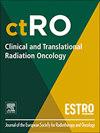肾癌立体定向放射治疗的生物学性别表现和报告:临床研究综述
IF 2.7
3区 医学
Q3 ONCOLOGY
引用次数: 0
摘要
背景:立体定向放射治疗(SBRT)正在发展成为肾癌的治疗方式,同时人们越来越认识到性别作为生物变量(SABV)政策的重要性,从而产生更深入的见解。目的:本综述旨在评估原发性局部肾癌SBRT临床研究中男性和女性患者的代表性以及性别特异性结果的报告。方法在EMBASE、CINAHL、Web of Science等数据库中选择合适的检索词进行检索。通过男女比例、性别特异性治疗结果的报告以及在单因素和/或多因素分析中将性别作为变量来评估生理性别的考虑。主要发现:纳入22项研究。961例患者(注明性别)中,29.24%为女性,研究中平均男女比例为2.57,标准差为1.22。年份、地区、研究类型与记录的男女比例无关(卡方检验,p分别= 0.099、0.29、0.719)。只有6项研究包含了性别,其中3项报告了基于性别的结果,3项包括了针对性别的分析。在这些研究中,只有一项研究报告了生存率的显著差异。结论支持SABV的整合将为SBRT在肾癌治疗中的应用提供更加公平和生物学知情的证据。本文章由计算机程序翻译,如有差异,请以英文原文为准。
Biological sex representation and reporting in stereotactic body radiotherapy for kidney cancer: A review of clinical studies
Background
Stereotactic body radiotherapy (SBRT) is evolving as treatment modality for kidney cancer alongside increased recognition of the importance of sex as a biological variable (SABV) policy in generating deeper insights.
Purpose
This review aimed to assess the representation of male and female patients and the reporting of sex-specific outcomes in SBRT clinical studies for primary localised kidney cancer.
Methodology
A database search with appropriate search terms was carried out on EMBASE, CINAHL, and Web of Science. Consideration of biological sex was assessed with the male: female ratio, reporting of sex-specific treatment outcomes, and inclusion of sex as a variable in univariate and/or multivariate analysis.
Main findings:
Twenty-two studies were included. Of 961 patients (with sex stated), 29.24 % were females, with a mean male to female ratio of 2.57 and standard deviation of 1.22 across the studies. There was no relationship between the year, region and study type, and the male to female ratio recorded (Chi-squared test, p = 0.099, 0.29, and 0.719 respectively). Only six studies were sex inclusive, with three reporting sex-based outcomes, and three including sex-specific analysis. Of these, only one study reported significant difference in survival.
Conclusion
Supporting the integration of SABV will promote more equitable and biologically informed evidence for the use of SBRT in the management of kidney cancer.
求助全文
通过发布文献求助,成功后即可免费获取论文全文。
去求助
来源期刊

Clinical and Translational Radiation Oncology
Medicine-Radiology, Nuclear Medicine and Imaging
CiteScore
5.30
自引率
3.20%
发文量
114
审稿时长
40 days
 求助内容:
求助内容: 应助结果提醒方式:
应助结果提醒方式:


